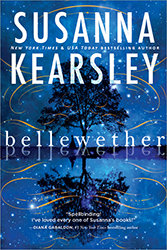Recommended to me by friend Anne Zald, Susanna Kearsley is a new author to me and a prolific writer of historic novels, often with a romance plot line to them. This is her most recent book (2018) and is told in alternating chapters by a contemporary museum curator, Charley, and by two of the historic figures she is researching, Lydia Wilde, and Jean-Philippe de Sabran, The setting is the north shore of Long Island in the present day and, alternately, in 1759, during the final stretch of the Seven Years War in the theatre of eastern Canada. Kearsley provides extended notes after the story detailing the actual historical figures upon whom many of her characters were based.
Charley has come to Millbank after her brother, Niels, suddenly died of a heart attack. His daughter, Rachel, although a young adult, was left the house and Charley has come to stay with her and taken a 2-year contract with a local group that's in the process of turning the historic house belonging to the Wilde family into a museum. That means she's left behind her boyfriend, Tyler (who everyone else thinks is a jerk), and they are trying to maintain a long-distance relationship. You pretty much know from the beginning that it's not going to work out. The love interest in Millbank is the contractor who is rehabbing the house.
Jean-Philippe is a captured French officer who has been billeted in the Wilde household, along with another French officer, while waiting exchange. Lydia runs the Wilde house after the death of her mother. Her father and two brothers as well as a young black woman, Violet, also live there. The work seems endless to maintain the farm and Jean-Philippe soon pitches in to help with the manual labor. He falls in love with Lydia, who at first despises him because of the death of her fiancé in the war. The French are, after all, the enemy.
Charley wants to make the story of a doomed love affair between Jean-Philippe and Lydia part of the narrative of the museum, although other museum board members are adamantly opposed. The house and its ghostly inhabitants have a mind of their own and secrets are gradually revealed that tell a very different story about the Wildefamily and the events that transpired.
It took me quite a while to get into this book, but in the end, it was worth the read. I am a fan of good historical fiction and appreciate the research that goes into grounding the stories. Brief but positive review from the Historical Novel Society, and a personal piece about Kearsley's own family history that ties into the book in Publishers Weekly.
Charley has come to Millbank after her brother, Niels, suddenly died of a heart attack. His daughter, Rachel, although a young adult, was left the house and Charley has come to stay with her and taken a 2-year contract with a local group that's in the process of turning the historic house belonging to the Wilde family into a museum. That means she's left behind her boyfriend, Tyler (who everyone else thinks is a jerk), and they are trying to maintain a long-distance relationship. You pretty much know from the beginning that it's not going to work out. The love interest in Millbank is the contractor who is rehabbing the house.
Jean-Philippe is a captured French officer who has been billeted in the Wilde household, along with another French officer, while waiting exchange. Lydia runs the Wilde house after the death of her mother. Her father and two brothers as well as a young black woman, Violet, also live there. The work seems endless to maintain the farm and Jean-Philippe soon pitches in to help with the manual labor. He falls in love with Lydia, who at first despises him because of the death of her fiancé in the war. The French are, after all, the enemy.
Charley wants to make the story of a doomed love affair between Jean-Philippe and Lydia part of the narrative of the museum, although other museum board members are adamantly opposed. The house and its ghostly inhabitants have a mind of their own and secrets are gradually revealed that tell a very different story about the Wildefamily and the events that transpired.
It took me quite a while to get into this book, but in the end, it was worth the read. I am a fan of good historical fiction and appreciate the research that goes into grounding the stories. Brief but positive review from the Historical Novel Society, and a personal piece about Kearsley's own family history that ties into the book in Publishers Weekly.

No comments:
Post a Comment